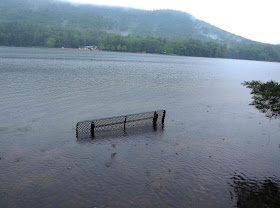Regular readers of this blog may remember this photo I posted last Wednesday, confessing I didn't know what this plant was. In that same post I then described how some plant-expert Facebook friends suggested it was probably a state-listed Threatened species called Borodinia missouriensis (or Boechera missouriensis, as some other sources call it). This photo shows the plant gone to seed, displaying its distinctive arching siliques. Could I find the same species in flower?
Well, yes! I could! So I returned to the site and collected another specimen, one that still had its tiny four-petaled white flowers just peeking out of its clustered buds. And while I was there, on a powerline trail that runs along the top of Mud Pond at Moreau, I counted over 40 individual plants along a stretch of trail maybe 50 yards long. Wow! If this truly is that threatened Borodinia missouriensis (also called Green Rock Cress), it isn't exactly a rare plant at this location! I will send both specimens -- one in seed, the other in flower -- to a state botanist who will ascertain this plant's identity for sure.
Meanwhile, I remembered finding a plant that looked like this along the sandy shore of a cove at Moreau Lake, so I went there today to see if I could find it. I was planning to walk along the shore, the same shore where a few years back I found another rare plant called Whorled Mountain Mint (Pycnanthemum verticillatum var. verticillatum), that one an Endangered species and really rare. This would be a good time to also check on that population. Or so I thought. But when I reached where that shore once was, I had to think again. This year, the lake is so high the water reaches all the way into the woods. There remains no sandy shore.
I remembered exactly one location where that mountain mint had thrived by the hundreds. Today, that location was well under water, thanks to a spring and summer when it has rained nearly every day. (And since Moreau Lake is a kettle lake with no inlet or outlet, whatever water falls into it, stays in it.) Oh dear! Will our Whorled Mountain Mint population survive this flooding?
Probably it will. I still found many plants of Whorled Mountain Mint on higher ground, so I imagine this native plant will spread out again once the flooding recedes.
Also there, on what little remained of a shore between water and steep forested banks, I found the other plant I believed I might find here, the Mustard-family plant we believe could be Borodinia missouriensis, its distinctive arching seedpods reflecting the afternoon light.
I counted at least a dozen there along the shore, and then when I continued on, I found quite a number more of the same, back in the shady woods. I'm SO glad to know that, whatever its name, this plant is happy here!
And was I happy, too? Well, what do you think this certifiably nutty plant nerd was? Ya, you betcha! Oh heck, I'll even be happy enough if this mystery mustard turns out to be just another common weed. At least I will then know its name and I can enter it on my life list.
In the meantime, I also delighted in all the pretty pink Pasture Roses (Rosa carolina) that were blooming along this shore, wafting their incredible fragrance on the warm humid air of this muggy day. I could distinguish this low-growing rose from similar roses by its solitary flower, narrow stipules, and the few straight slender thorns on the upper branches. Mmm, I can almost detect its scent just by gazing at this photo!
I also enjoyed finding the yellow trumpets of Bush Honeysuckle flowers (Diervilla lonicera), the leaves glossy-green in the rain that was falling steadily by now.
Here was a Painted Turtle! Was she out of the water, wandering the shore, looking for that broad sandy beach where she laid her eggs last year?
Sorry, Mama. That broad sandy beach is well under water this year. I hope you find another spot to your liking.
Does anyone remember resting on this bench, watching the sun go down behind the mountains that rise from the western shore? Or does anyone remember how we feared that Moreau Lake was draining out through a crack in the earth's crust or something awful like that, its water level having dropped four feet --FOUR FEET!!! -- in just a few years? I wonder now how many years will pass before we can sit on this bench once again.











Congratulations on all your wonderful finds! On a bird trip recently with Hudson Mohawk Bird Club to the Lost Valley State Forest I saw three different kinds of "wild" roses. One was the typical white invasive Hell roses, but the other two were similar to this, single and in shades of pinkish and pinkish yellow. I wonder what they were.
ReplyDeleteThere seems to be water, water everywhere this year, the prognosis is that as the climate changes the northeast will receive more rainfall than in the past.
ReplyDeleteThat's quite an interesting plant, whatever it is.
ReplyDelete